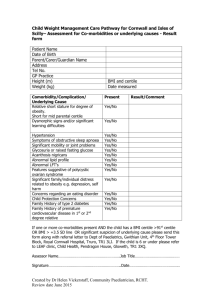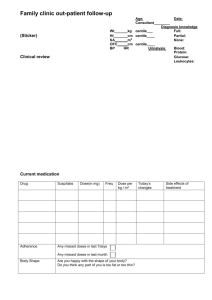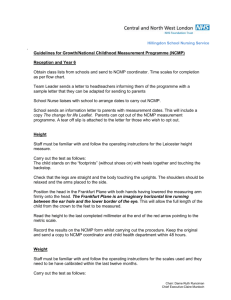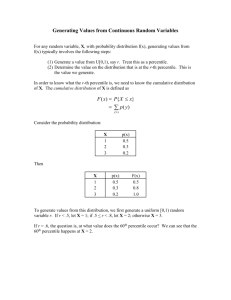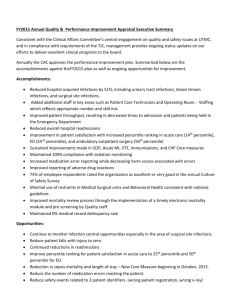pubdoc_12_21620_938
advertisement
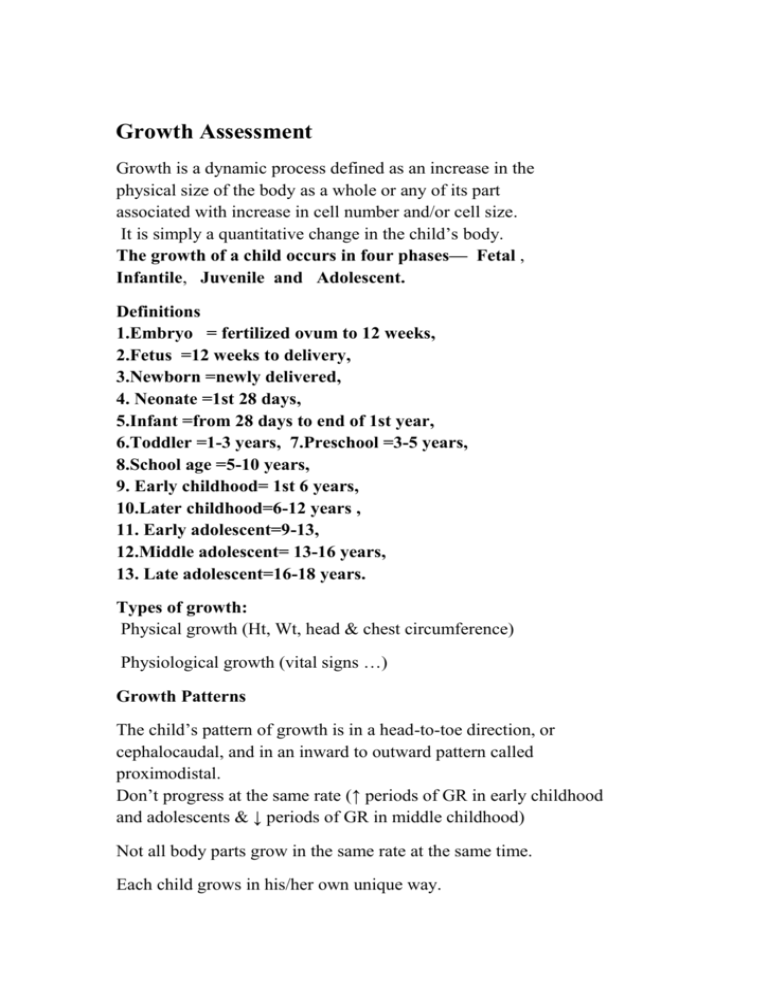
Growth Assessment Growth is a dynamic process defined as an increase in the physical size of the body as a whole or any of its part associated with increase in cell number and/or cell size. It is simply a quantitative change in the child’s body. The growth of a child occurs in four phases— Fetal , Infantile, Juvenile and Adolescent. Definitions 1.Embryo = fertilized ovum to 12 weeks, 2.Fetus =12 weeks to delivery, 3.Newborn =newly delivered, 4. Neonate =1st 28 days, 5.Infant =from 28 days to end of 1st year, 6.Toddler =1-3 years, 7.Preschool =3-5 years, 8.School age =5-10 years, 9. Early childhood= 1st 6 years, 10.Later childhood=6-12 years , 11. Early adolescent=9-13, 12.Middle adolescent= 13-16 years, 13. Late adolescent=16-18 years. Types of growth: Physical growth (Ht, Wt, head & chest circumference) Physiological growth (vital signs …) Growth Patterns The child’s pattern of growth is in a head-to-toe direction, or cephalocaudal, and in an inward to outward pattern called proximodistal. Don’t progress at the same rate (↑ periods of GR in early childhood and adolescents & ↓ periods of GR in middle childhood) Not all body parts grow in the same rate at the same time. Each child grows in his/her own unique way. Analysis of growth 1 –for infant, size in 1st 2years= reflect intrauterine life, size more than 2years= midparental 2- In infant, the linear growth was taken by measuring board(supine)or horizontal stadiometer, older(2 years and above)by vertical stadiometer. 3- WT for HT, <5th centile remain the single best indicator for acute under nutrition, while it is normal in chronic malnutrition. 4- Chronic and severe malnutrition in 1st year of life may limit the head growth( ominous sign of late cognitive disability). Growth chart The most powerful tool in assessing of growth, each chart contain 7 or 8 percentile. there is separated chart for male and female and according to age. Growth chart to be significant , need serial reading not only single reading Types of growth chart WT for age, HT(length, stature) for age, OFC for age, WT for HT, BMI. There are special chart for premature baby(catch up growth), Down syndrome, Klinfelter syndrome. The weight(WT) Birth wt 2.500-3.750 gram, decreasing in about 5- 10% in 1st 10-14 day of life, as result of : 1.Withdrawal of hormones from mother. 2.Loss of excessive extra cellular fluid. 3.Passage of meconium (feces) and urine. 4.Limited food intake. then gained in about 20-30 g/day in the remaining 1st month, then 750 gram/month in the next 2month. 3-12month= age in month+9/2 1-6years= age in years x2+8 6-12 years=age in years x7-5/2 The above equations give idea about the rough ideal body wt. The birth wt was doubled at the age of 6month ,and tripled at the age of 12month, quadruple at 24months. WT gain in 2nd year 0.25g/month while after 2nd year till adolescence annual increment 2-3Kg. Body wt less than 5th centile =underweight Body wt more than 95th centile =overweight Weight for age percentile 25 percentile e.g.: if the 9-mo age line intersects the 25th percentile curve at 8kg, indicating that 25% of the 9-mo-old girls in the growth chart sample weigh less than 8 kg (75% weigh more). The height (HT) Supine=length(less than 2year) Standing=stature(more than 2year) At birth =50 cm At the end of 1st year=75cm 2-12 year=age (in years)x7+66cm At age of 2year, in BOY, final adult HT=HT at this age x2 At age of 18month, in GIRLS, final adult HT= HT at this age x2 The birth HT doubled at the age of 4years and tripled at the age of 13 years. In 2nd year increase 12 cm/year while after 2nd year till adolescence increase 5cm/year The best predictor of child eventual adult HT is MID parntal HT For Boys=mother HT+13cm +father HT/2 For Girls=father HT -13cm +mother HT /2 This is give approximately +/-5cm of final adult HT HT less than 5th centile=SHORT stature HT more than 95th centile =TALL stature Weight for Height percentile 3rd percentile e.g.: if a girl of 74cm length has 8kg weight. Then she intersects the 3rd percentile, indicating that 3% of the girls with such length have weight below 8kg in the growth chart sample. (regardless the age) occcipitofrontal circumference (OFC) OFC indicate brain growth but not intelligence: The measurement should be taken with a device that cannot be stretched, such as a flexible metal tape measure. Wrap the tape around the widest possible circumference - from the most prominent part of the forehead (often 1-2 fingers above the eyebrow) around to the widest part of the back of the head. Try to find the widest way around the head. measure 3 times, and take the largest one. At birth =35 cm +/- 2cm In 1st 3months= increase 2cm/month In the next 3 months= increase 1cm/month In the next 6months= increase 0.5cm/month At the end of 1st year =47cm,at 2nd year=49 At the end of 4th year=51cm, 8th year=53 At 12 years 55cm OFC less than 5th centile=microcephaly OFC more than 95th centile =macrocephaly Body Mass Index(BMI) Wt(KG)/ht(M2) Measure the adipose tissue in the body BMI for age < 5th centile=underweight BMI for age between 5th-85th percentile=healthy BMI for age between 85th-95th percentile= risk of overweight BMI for age >95th percentile=overweight(obese) BMI Categories: Underweight = <18.5 Normal weight = 18.5–24.9 Overweight = 25–29.9 Obesity = BMI of 30 or greater CLASS I OBESITY=30-34 CLASS II OBESIY= 35-39 CLASS III OBESITY=>40 Others indictor of growth 1 . Body proportion Upper body segment/Lower body segment(U/L) At birth=1.7, 3years=1.3, more than 7years=1 or 0.9 Increase U/L= short limb, rickets, achondroplasia, hypothyrodism Decrease U/L =Marfan syndrome, scoliosis, spinal deformity 2 . Bone age Measure the somatic growth (skeletal maturation), radiograph of the hand and wrist. A . delayed bone age but with normal HT age(age at which the HT on 50th centile)=constitutional growth delay. B . marked delayed bone age (to chronological and HT age)=endocrinopathy 3.Dental Development Mineralization started in the 2nd trimester and go Eruption started in 5-6 months postnatal , central then lateral, mandibular then maxillary, delayed if no any tooth more than 13 months of age. Exfoliation (6 years). Teething by itself if used alone , is poor indicator. 4- arm span (from 2 finger tips across the shoulder which equal to HT at 3-4 years.
